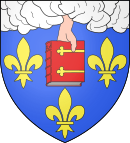French: Université de Paris | |
 | |
| Latin: Universitas magistrorum et scholarium Parisiensis[1] | |
| Motto | Hic et ubique terrarum (Latin) |
|---|---|
Motto in English | Here and anywhere on Earth |
| Type | Corporative, then public university |
| Established | Origin: High Middle Ages at the Parisian cathedral school Founded: 1045–1150 Suppressed: 1793 Faculties reestablished: 1806 University reestablished: 1896 Divided: 1970 |
| Location | , |
| Campus | Urban |
The University of Paris (French: Université de Paris), known metonymically as the Sorbonne (French: [sɔʁbɔn]), was the leading university in Paris, France, from 1150 to 1970, except for 1793–1806 during the French Revolution. Emerging around 1150 as a corporation associated with the cathedral school of Paris, it was considered the second-oldest university in Europe.[2] Officially chartered in 1200 by King Philip II and recognised in 1215 by Pope Innocent III, it was nicknamed after its theological College of Sorbonne, founded by Robert de Sorbon and chartered by King Louis IX around 1257.[2]
Highly reputed internationally for its academic performance in the humanities ever since the Middle Ages – particularly in theology and philosophy – it introduced academic standards and traditions that have endured and spread, such as doctoral degrees and student nations. Notable popes, royalty, scientists, and intellectuals were educated at the University of Paris. A few of the colleges of the time are still visible close to the Panthéon and Jardin du Luxembourg: Collège des Bernardins (18 rue de Poissy, 5th arr.), Hôtel de Cluny (6 Place Paul Painlevé, 5th arr.), Collège Sainte-Barbe (4 rue Valette, 5th arr.), Collège d'Harcourt (44 Boulevard Saint-Michel, 6th arr.), and Cordeliers (21 rue École de Médecine, 6th arr.).[3]
In 1793, during the French Revolution, the university was closed and, by Item 27 of the Revolutionary Convention, the college endowments and buildings were sold.[4] A new University of France replaced it in 1806 with four independent faculties: the Faculty of Humanities (French: Faculté des Lettres), the Faculty of Law (later including Economics), the Faculty of Science, the Faculty of Medicine and the Faculty of Theology (closed in 1885).
In 1896, a new University of Paris was re-founded as a grouping of the Paris faculties of science, literature, law, medicine, Protestant theology and the École supérieure de pharmacie de Paris. It was inaugurated on November 19, 1896, by French President Félix Faure.[5] In 1970, after the civil unrest of May 1968, the university was divided into 13 autonomous universities, which today are the Sorbonne University, Panthéon-Sorbonne University, the Assas University, the Sorbonne Nouvelle University, the Paris Cité University, the PSL University, the Saclay University, the Nanterre University, the Sorbonne Paris North University, the Paris-East Créteil University and the Paris 8 University. The Chancellerie des Universités de Paris inherited the heritage assets of the University of Paris, including the Sorbonne building, the "La Sorbonne" brand, control of the inter-university libraries, and management of the staff of the Paris universities (until 2007).[6]
- ^ Records of The Tercentenary Festival of Dublin University. Dublin, Ireland: Hodges, Figgis & Co. 1894. ISBN 9781355361602.
- ^ a b Charles Homer Haskins: The Rise of Universities, Henry Holt and Company, 1923, p. 292.
- ^ "Sorbonne facts". Paris Digest. 2018. Retrieved 2018-09-06.
- ^ Palmer, R. R. (1975). "27, The National Convention orders the sale of all college endowments". The School of The French Revolution : A Documentary History of the College of Louis-le-Grand and its Director, Jean-François Champagne, 1762–1814. Princeton: Princeton Legacy Library. p. 127. ISBN 978-0-69-161796-1.
- ^ "Histoire de l'université | Université Paris 1 Panthéon-Sorbonne". www.pantheonsorbonne.fr. Retrieved 2024-01-16.
- ^ "La Chancellerie des universités de Paris a 50 ans". Académie de Paris (in French). Retrieved 2024-10-17.
